acacia berry
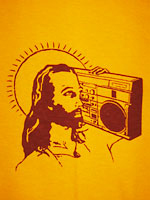
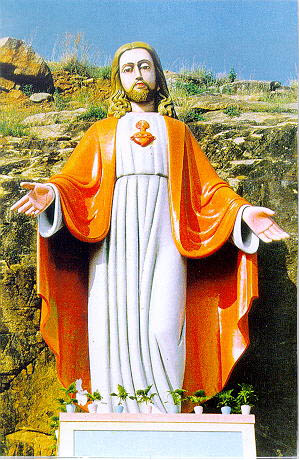
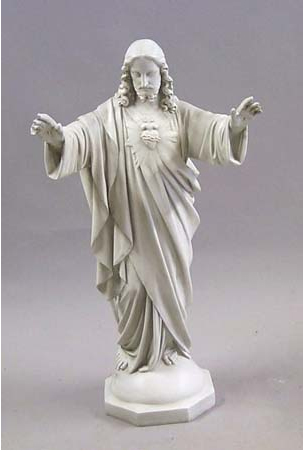
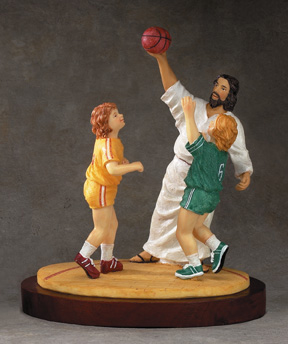
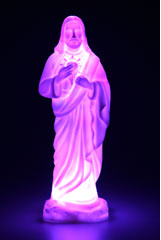
The categories ‘traditional’, ‘grey area’, and ‘extreme’ are reflective of my initial reactions to the varying Jesus imagery on the market today. Although I do not consider myself Catholic, I have a sense of how the ‘grey area’ or ‘extreme’ cases could be seen as blasphemy. Why is this so? Both categories rely on the familiar image of Jesus, but boldly take him out of his heavenly context or natural color. Are these the only factors manipulating people’s perception this Catholic religious figure? To answer these questions and other, I compare our modern day images of Jesus to cultural significance of Egyptian ancestor stelae and bust during the 18th- 20th Dynasty (Meskell 2004:70). Using Gell’s approach, I also emphasize the role of agency and art in our perceptions of religious figures.
Made of limestone, Egyptian ancestor stelae and busts were considered vessels that embody deceased ancestors. These statues had several functions, including a portal of communication between the living and the dead, eternal remembrance, and to provide celestial aid for the mortal. To maintain positive relations with these ancestors, Egyptians performed reciprocal rituals that took place in sacred niches located in the first or second rooms of a dwelling (Meskell 2004:70). Although the ancestors infused in the stelae and busts varied, archaeologists had later uncovered several unfinished busts at a local storehouse. In another words, many of these locally produced busts were not carved because of divine inspiration through the artist. Instead, these objects were mass produced and then “made to order” when requested by an individual (74).
I use the Egyptian example to make a point about mass production and the use of a specific material for a religious image. In the case of the Egyptian stelae and busts, most if not all versions of these objects were made of the same material, limestone. One contrast that can be made between the three categories of Jesus’ is the varying use of materials used to create these images. If we take a look at ‘traditional’ mass produced objects, they are often made of a grey stone, use a ceramic glaze using neutral colors, or delicate glass. The ‘grey area’ pieces seem to follow this same pattern, but the context of his presence slightly altered for modern times. On the other hand, ‘our extreme’ examples are often made of cheap plastic/cotton and use bright colors and have ironic religious messages. Why is the use of specific material or colors a threat to an object’s sacredness?
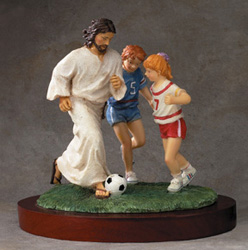
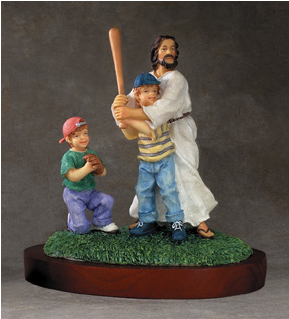

The use of color and material is just one aspect of a larger issue. Putting religious beliefs aside, these Jesus figurines/statues are just... objects. If we consider the manufacturing aspect of the examples above, the Jesus statue in the church is no different than the LED lamp Jesus. Both are examples of products from a mass market that were molded, painted, and hammered in the same fashion. Yet, when the relationship between individuals and objects is taken into account, one can see how an everyday object can turn into ritualized entity.
According to Gell, agency is the “possession of the mind that ‘intends’ actions prior to performing them” (1998:125). Human agency is the force behind the existence of ritual practices. It is the ritual that often creates binary boundaries, such as good vs. evil, right vs. wrong, and in this case, holy vs. profane. ‘Traditional’ Jesus images are traditional because they have been ritualized within Catholicism. For example, the ‘traditional’ Jesus statue is found in the front of the church or in a created sacred space within someone’s home. The presence of this statue brings about a series of rituals such as bowing in front of the Jesus statue before entering the pew area, lighting prayer candles in front of a Jesus statue, provide protection for your home/car, and in rare cases Jesus statues can also exhibit healing powers. Similar to the Egyptian ancestor stelae and busts, there is also a reciprocal relationship created between the individual and these embodied objects including the Eucharist (bread and wine portion of a Liturgy), confession, and offering.
Although this term can be controversial among religious sects, ‘traditional’ Jesus statues have idolistic characteristics because much of the ritual in Catholicism incorporates the image of the ‘traditional’ Jesus, whether in the form of a statue, stained glass, etc. Because of his worldwide familiarity, the ‘traditional’ images have also become iconic. Iconic idols are considered an index “physically resembling a prototype, usually a human being… where the protoype is a god, whose ‘likeness’ is mediated by the artist,” (Gell 1998:97). This is key to understanding why ‘grey area’ and ‘extreme’ images are threatening to the sacredness of Jesus Christ. Note that both categories incoporate the familiar image (the idolicized image) of Jesus Christ, but use different strategies to slightly disassociate it from its familiar sacred context. Refer back to the Jesus Inspirational Sports figurines. Jesus is not portrayed as a man who has taken the burden of everyone’s sins or as a guardian. Instead, he is given more human like qualities by actively playing sports with children. The uses irony for the “Light of the World” or “Answer Me” Jesus is clever but de-mystifies scripture.
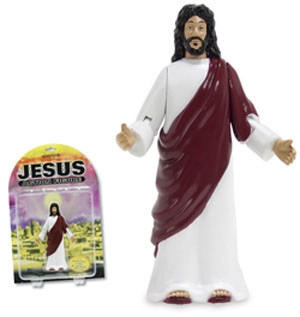
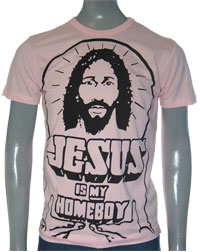
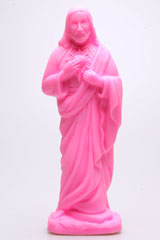
“...the artist has to produce a ‘faithful’ rendition of the accepted image of the body of the god, triggering recognition of the god among his worshipers,” (Gell 1998:99). Familiarity is at the heart of this conflict. The artists on both ends have similar marketing strategies by exploiting and mass producing a familiar image that represents a positive aspect of life. The iconic nature of Jesus is the catalyst for devout Catholics building giant statues in his likeness and is also responisible for the continued success of ‘extreme’ Jesus objects among the younger Christian and secular audience. No matter what form Jesus takes, his worshipers will always consider him the light of world, whether that light is white, green, blue, red...
references
Gell, A. 1998. Art and Agency. Oxford: Claredon Press.
Meskell, L. 2004. Object Worlds in Ancient Egypt: Materiality Biographies Past and Present. Berg